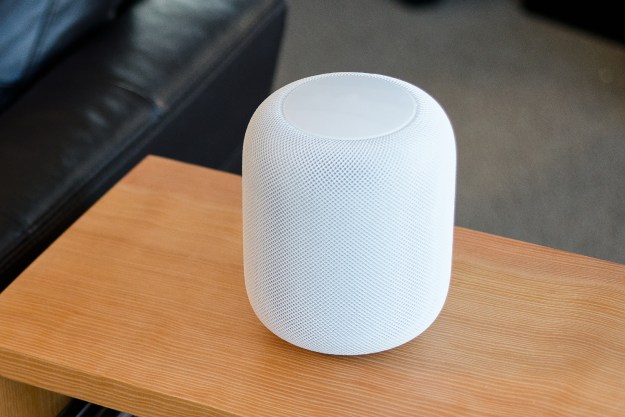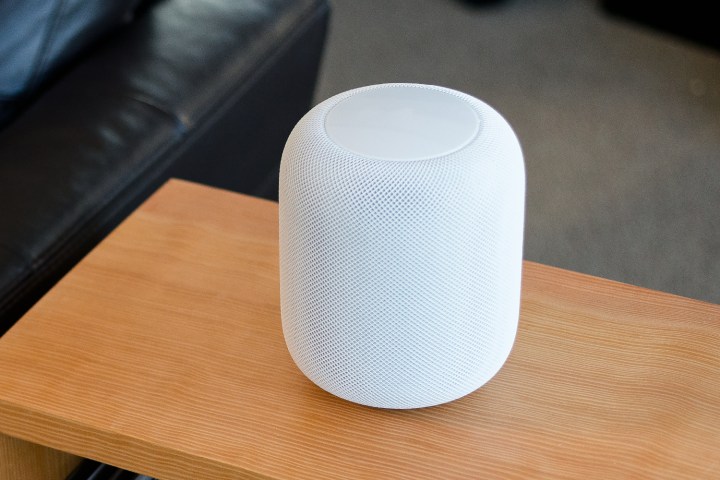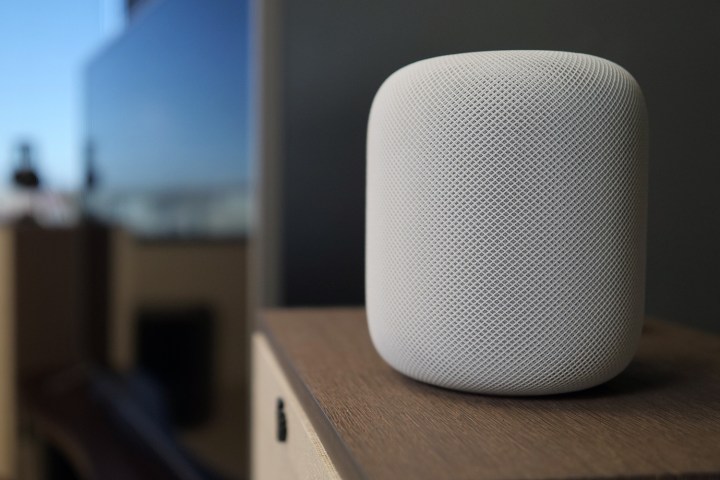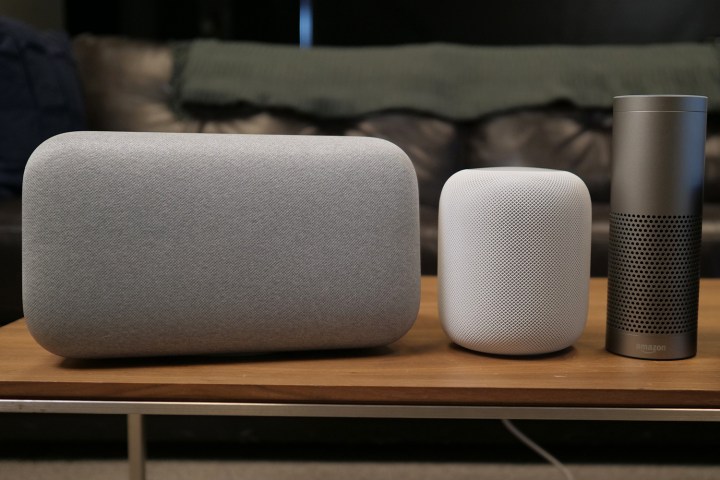
“The HomePod is one of the best-sounding smart speakers you can buy, but only Apple fans will care.”
- Excellent, nuanced sound
- Great design
- Easy HomeKit setup and control
- Streaming support via AirPlay
- No built-in support for Spotify, Pandora, or other apps
- Requires iOS device running iOS 11.2.5 to set up
- No Bluetooth or Aux jack for non-iOS devices
The Apple HomePod is finally here. We’ve been anticipating a smart speaker from Apple since Amazon’s Echo invented the category in 2014. But naturally, Apple put its own twist on the concept. At $350, the HomePod emphasizes sound quality more than smarts, and of course, the design and simplicity are pure Apple.
We know Apple prefers to perfect something before it brings a new product to market, so we’re not shocked it’s taken more than three years to see a rival to the Echo. But did Apple get it right?
In many ways, the HomePod is better than anything else you can buy in this space. In others, it’s an utter disappointment.
Out of the box
The HomePod’s out-of-box experience may be Apple’s most simplified and elegant product presentation yet — you pull out the speaker and you’re done. There’s a little product card and that’s it — no pomp or circumstance.
The speaker feels great. At 5.5-pounds it has real heft, and that’s because of robust cabinetry and huge magnets on the drivers inside. This HomePod is built like a tank, and it needs to be if it’s going to produce big bass, which — spoiler alert — it does. More on that in a moment.
The HomePod’s power supply is built into the speaker, which means there’s no brick to hide (thank you, Apple!) The supplied power cord is covered in a braided textile, which brings some additional class to the speaker. The soft, squishy material used for the speaker grill looks and feels great, too – it’s hard not to want to squeeze it — and Apple says the material is acoustically transparent, so it shouldn’t alter the speaker’s sound quality.
The setup
We’ve established that the HomePod looks and feels great. Now it’s time to set it up. First, you’ll need to pull out your iPhone. Oh, you don’t have an iPhone? Well, that’s going to be a problem, and is a major sticking point for us. To set up the HomePod, you must have an iOS device capable of running iOS 11.2.5 — no other phone will do. If you don’t have an iPhone 5S or later, iPad Mini 2 or later, or iPod Touch 6th-gen or later, then you’re probably not buying this speaker. The HomePod is designed for the Apple faithful, which will be a consistent sticking point for any heathens who dare stray from the congregation.
If you have one of those iOS devices, setup is great. You’ll want to make sure you have Apple KeyChain turned on and two-factor authentication enabled. You’ll also want to make sure you are connected to your Wi-Fi router and that Bluetooth is turned on in your device. At that point, just hold your device next to the speaker, click a few ‘OK’ buttons, and the HomePod practically sets itself up. It connects to your Wi-Fi router, imports your Apple Music credentials, and you’re good to go.
If you’re still with us, we presume it is because you have an iPhone and love using Apple Music, because that’s the only source of music you can play using voice commands. You can’t ask Siri to play any of your Spotify playlists, and she won’t help you with Pandora, either. You can play Spotify and some other music or video apps using AirPlay, but there’s no Bluetooth connection and no auxiliary input jack to connect non-Apple devices.
If you love using Siri, you’ll be pleased to hear that her integration in this speaker is Apple’s best yet.
If you love using Siri, you’ll be pleased to hear that her integration in this speaker is Apple’s best yet. Occasionally we got some alternate version of the song we asked to listen to, but otherwise, Siri plays what we want to hear and can tell us things about the music or musicians if we ask. For example: “Hey Siri, tell me more about this singer.” Now you can also search by song lyric.
Siri can also answer a long list of questions about the weather or U.S. History – just like other smart speakers – and she’ll read the news from NPR, Fox, CNN and other outlets. While basic stuff like setting multiple timers and making phone calls wasn’t available when the HomePod was initially released, now you can do both of those things. You can also set your language to Spanish in the United States, Spain, and Mexico and to French in Canada.
But Siri’s real value is in playing music and controlling IoT devices like smart lights, smart door locks, and smart thermostats, all through Apple HomeKit.
We appreciate Apple HomeKit’s ease of use. If you have devices that work with HomeKit — and there are a lot of them — you pop into the HomeKit app, register your devices, and they will be operable through Siri voice commands. You can take it a step further and set up “scenes” like “Good Morning,” which can turn on the lights in the kitchen, start a kettle or coffee maker, and start playing a morning playlist if you want. In a world where smart devices can be a little too smart for their own good, Apple makes it easy to control it all with Siri. That’s a big win … for Apple lovers.
The HomePod can also serve as a speakerphone for iPhone calls, and Siri will read and dictate text messages so you can have an entire conversation hands-free. Some have voiced alarm about the possibility that someone could hijack your phone and send nefarious messages or make unauthorized calls. It’s possible. If you have a big house and tend to wander far from your speaker, this could be an issue, but Apple points out that the iPhone connected to HomePod must be on the same network for messaging and call functions to work. Most folks will probably hear their messages being snooped on by others. In short, the likelihood someone is going to pry into your messages or send messages on your behalf without your knowledge is slim, but it’s there.
Unlike
Unlike Google Assistant, Siri won’t recognize different voices, which will lead to the kind of inconveniences that Apple usually prides itself on fixing. For instance, because a HomePod connects to one person’s phone and Apple ID, it’s inextricably tied to that person’s Apple Music account, playlists, and musical taste. If the owner is into jazz and R&B, a roommate who decides to play speed metal one day would do some damage to the customized music suggestions Apple is so proud of. It’s called a HomePod, not a PersonalSpeakerPod.
One positive security note: Apple says almost all the information that gets passed back and forth from the HomePod over the internet is secure and anonymous. The only info Siri shares with Apple is your listening history, which it uses to build customized playlists to suit your tastes.
Under the hood
We’ve already covered a lot about what the HomePod can and can’t do, but we’re just getting started here. Inside is Apple’s powerful A8 processor – the same chip in the iPhone 6 and 6S — which the speaker uses to actively manage sound. The HomePod is constantly listening to its environment, changing the EQ curve, and beamforming – essentially steering sound – to optimize sound quality for its environment. The idea is you that should hear the speaker, not the room.
If we were to put the HomePod in a corner, for instance, the speaker would notice a change in the midbass region and compensate by reducing certain frequencies for cleaner sound. The speaker will also aim the sound’s direction out into the room rather than into a wall. Move the speaker elsewhere and it will adjust in real time. There are no bad seats with the HomePod – it sounds great everywhere.
All those sonic smarts are routed to one 4-inch woofer and seven tweeters surrounding the speaker, each assigned its own high-power amplifier. The 4-inch woofer comes with one heck of a beefy voice coil and can move a total of 20mm, peak-to-peak. This means the speaker can move a serious amount of air. And you’ll feel it the moment you plug the speaker in.
As promised, the HomePod sounds excellent.
Finally, we get to sound quality, which really is this speaker’s best attribute. As promised, the HomePod sounds excellent. We set it up against an Amazon Echo 2nd gen, a Google Home Max, and a Sonos One, did some listening, and took copious notes.
From the very first note we were impressed with the HomePod’s fidelity. We’ve never whipped out the audiophile lexicon for a smart speaker before, but the HomePod demands it. Where the Google Home Max is an oafish brute, the HomePod is an agile athlete with explosive force at the ready.
We kicked off our listening session with the title cut from Bruno Mars’ 24K Magic and were immediately struck with the highly resolved sawtooth edge of the song’s opening vocoder sequence. We heard complex harmonics within the synthesizers normally exposed only by the finest
And yet, here it is. Apple doesn’t let the HomePod’s bass fly around with reckless abandon, either. With the A8 chip keeping it in check, bass never blasted into distortion territory. The result was punchy, tuneful, legitimately taught bass that you rarely get from cheap subwoofers, much less a compact smart speaker.
Apple prioritizes vocals with its processing, but the company’s sound engineers stopped short of pushing them so far forward in the mix that they felt exposed. Apple told us in a private meeting that the HomePod is designed to separate audio into primary and secondary sound energies, then route those signals out to different drivers so that lead vocals sound front and center, while background vocals take on a more ambient presence; just imagine the kids’ chorus line on Pink Floyd’s Another Brick in the Wall.
The HomePod treats complex and intricate music with the respect it deserves. Just the first few seconds of Allison Krauss and Union Station’s New Favorite gave us chills. The click-y transients created by the opening guitar picks and the deep, metallic twang of the pedal steel leapt from the speaker and filled the room as if we were in the studio. Then Krauss came in with her lilting vocal, and the richness of her tone melted us.
You’re not getting that kind of sonic experience from the Amazon Echo. Nowhere near it. HomePod also sounds significantly cleaner and more balanced than the
More surprising is how well the HomePod matches some of the Sonos One’s excellent sonic attributes while also sounding bigger and omnipresent. Articulation is on par with the One, with equal resolution of fine detail, and depth of bass, but the HomePod has a fatter, more robust sound signature thanks to some amped-up midbass in the EQ curve. The HomePod is also really good at that 360-degree “sound everywhere” effect that others have tried and failed to create. The
This speaker isn’t made for everyone. It’s made for iPhone owners who love Apple Music.
This speaker isn’t made for everyone. It’s made for iPhone owners who love Apple Music. If you fall into this narrow demographic, you should buy one. After all, you probably just want a great-sounding speaker to play your music from the same service you already get it from. That’s what the HomePod does, and it does it extremely well. If you’re pretty much anyone else, though, we think the HomePod probably isn’t the right choice for you … and that’s too bad because it is the best compact smart speaker we’ve heard so far. Apple did some real innovating with the HomePod, it just didn’t make that innovation available to everyone.
Warranty information
Apple’s limited warranty covers defects in manufacturing for one year beginning on the date of purchase. Apple also offers AppleCare+ for the HomePod.
Our Take
While the Apple HomePod is an outstanding speaker, it is made for a very specific audience and excludes many potential users. Until the HomePod offers support for multiple streaming apps and has more third-party app and feature integration, its excellent sound quality isn’t enough to warrant buying one.
Is there a better alternative?
If you’re heavily invested in the Apple ecosystem, own an iOS device, and love Apple Music, then there’s no better alternative. For everyone else, we recommend the Sonos One as the most comparable in terms of sound quality, and as a far more flexible speaker.
How long will it last?
The HomePod feels built to last, and it will likely hold up well over time. The included mesh screen can’t be easily removed by the user, however, so it may get soiled over time. Also, this speaker doesn’t have any user-serviceable parts, so if it goes defective, a costly $270 repair is the only recourse. The lack of Bluetooth and auxiliary inputs means that if you ever decide to switch to
Should you buy it?
Do buy the HomePod if you are a hard-core Apple user and perfectly happy with Apple Music. Do not buy it if you own any phone other than an iPhone or want to listen to music sources other than Apple Music.
Updated in September 2018 to note that the HomePod now supports multiple timers, two-way calling, and different languages.
Editors' Recommendations
- SimpliSafe is now using AI to prevent burglars from entering your home
- What to do if your Amazon Alexa app is not working
- Echo Hub vs. Echo Show 15: Which is the best smart home gadget?
- Echo Hub vs. Echo Show 8: Which is the best option for your smart home?
- The best smart light switch for Alexa, Google Home, and HomeKit










